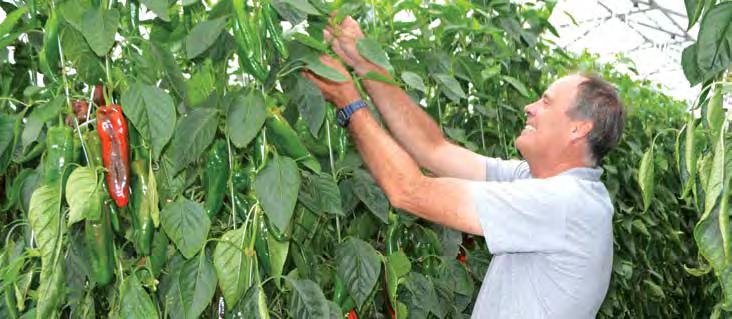
4 minute read
Energy and labour challenges with capsicum
ENERGY AND LABOUR
CHALLENGES WITH CAPSICUM
Words by Helena O’Neill
Gaven Naylor’s proud of Freshwest’s crop
Finding something viable to meets its energy needs is the biggest challenge facing capsicum grower Freshwest.
Gaven Naylor runs the Palermo capsicum growing business with his wife Vanessa on the outskirts of Waiuku.
The property uses coal-fired heating, recycled water in its irrigation system, and is serviced by an environmental computer network. Capsicum growing is energy intensive in the winter and requires a reliable heating source. Freshwest uses coal as there’s no other viable energy source for their size of operation. “Long term it’s definitely our biggest challenge, followed by labour. Both are really going to put the brakes on any future developments in New Zealand going forward. They’re really hard [challenges] to answer at the moment.” “This year we’ve just put on 35kW solar panels. We feed back to the grid what we don’t use. It’s pretty much taken care of all our electrical needs in the summer … on a sunny day over 50% is going back into the grid.” The business employs six full-time staff, excluding Gaven and Vanessa, and during the summer months they usually employ up to another four staff. “The key to getting through these tough times is having good staff. I would like more; this time of year we usually have seven or eight staff.” The national lockdown last year was “pretty scary” Gaven says, but he’s proud of how his staff handled the changes they had to put in place to meet government guidelines. As for the timing, the national lockdown came during the quiet part of their growing calendar.
“We were lucky, it was pure luck really. We were right in our low production period … planting had been done and it was basic crop maintenance, with a little bit of picking.” However, with reduced numbers of capsicums being exported, the domestic market has seen a larger volume available across the country. “The market has definitely been under pressure, it’s been difficult.”
Freshwest usually exports through New Zealand Gourmet, but not this season.

Some of Freshwest’s best
“The export market has been the one we’ve missed out on this year. It’s been tough with the lack of flights and the lack of ships. Hopefully, that will be the big change for the next season.”
Gaven and Vanessa bought Freshwest in 2004 and grow their Palermo capsicum crops in one hectare of greenhouses at Pukeoware, southwest of Auckland. They aim to produce all year round. Gaven has over 30 years of experience in the horticulture sector, gaining a Diploma of Horticulture after finishing school and working for a tomato grower at Whitford in southeast Auckland. That business was one of the first to grow musk melons for the Japanese market. “I was spending every New Zealand winter in Japan for four years learning how to grow melons. I’d come back and then travel all around New Zealand, teaching these young guys how to do it.” He spent several years growing melons before heading off on an OE with Vanessa.
“It’s a pretty unforgiving crop if you get it wrong. That industry died a pretty natural death really.”
Gaven and Vanessa then ended up as flower growers supplying Hypericum berries which are used in floral arrangements. “We got the opportunity to bring the Hypericum in from Holland, and did that for a few years on 20 acres or so with 50 staff at the peak of packing. It was crazy days!” “That market started getting under pressure by Zimbabwe and parts of South America. We could see our market getting squeezed, so when this property came on the market it was perfect.” When the Naylors bought Freshwest, the operation grew blocky capsicums and a small number of chillies. A few years later they saw the need to diversify and began trialling Palermo capsicums. “We were the first in New Zealand to trial it, over 10 years ago.” It all started with one trial row, adding an additional row of King Sweeties Palermo each year until they were fully Palermo with a small amount of Wee Sweeties snack capsicums. This is the first year that they are solely growing Palermo capsicums. “The Wee Sweeties were really, really labour intensive and packaging intensive. We had more demand for Palermos, so we got rid of them.” Demand is highest for the red and yellow King Sweeties, with a small number of green primarily sold to Asian stores.
“There are some growers of huge blocky capsicums and we were never going to compete with them. For us, it’s to find our little niche in the market. And it’s an amazing product.”










